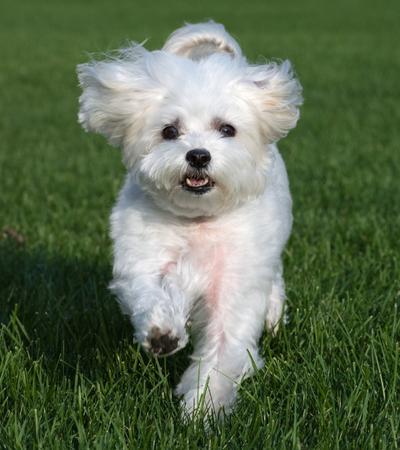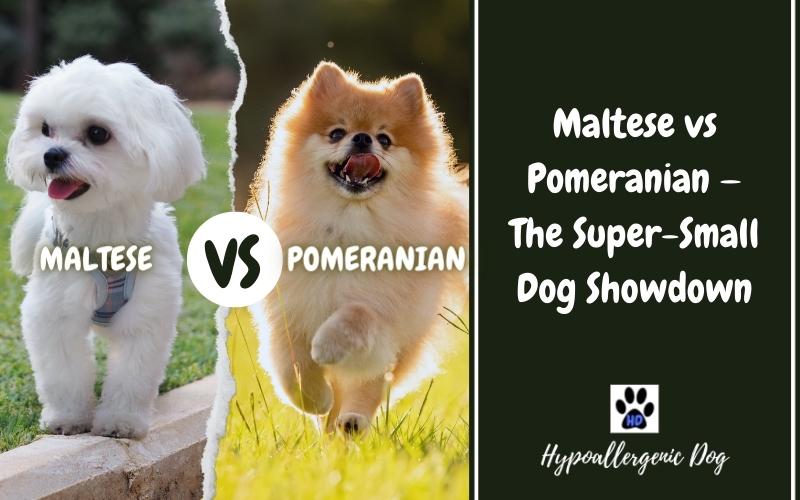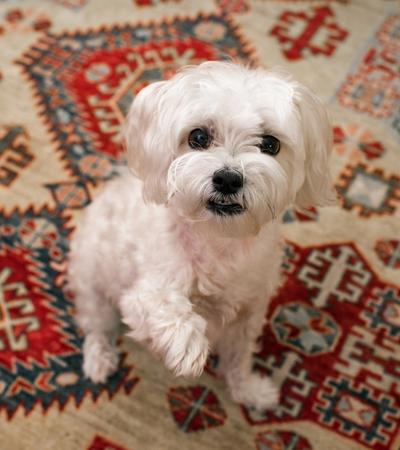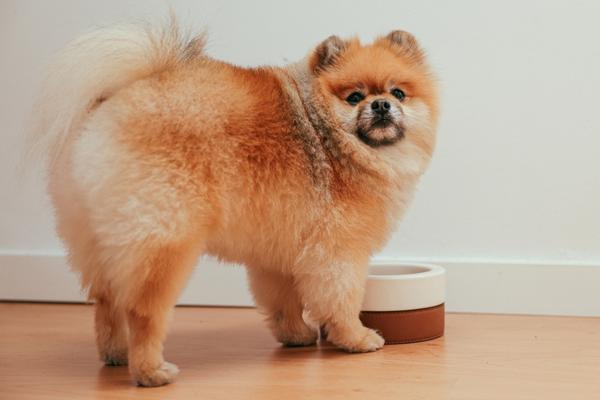Maltese vs Pomeranian — How Do They Differ?
If you’re looking for an adorable small dog with a luxurious coat, then look no further than the Maltese vs Pomeranian. These two breeds have many similarities in terms of their high-maintenance grooming needs, but there are several key differences too.
For people with dog allergies, there is one significant contrast between them, one is hypoallergenic, but the other isn’t.
To help you decide whether a Maltese or Pomeranian is the right breed for you, we’ve created the ultimate article, full of everything you need to know about these loving little dogs.
Maltese
Pomeranian
Personality
Affectionate
Loyal
Loving
Gentle
Energetic
Friendly
Intelligent
Loving
Friendly
Eager to please
Clever
Feisty
Gentle
Loyal
Family Dog
Yes
Not if you have young children
Height
7-9 inches
6-7 inches
Weight
6.5-9 pounds
3-7 pounds
Cost
Average from around $600 to $800
Average from around $600 to $800
Hypoallergenic
Yes
No
Lifespan
14-18 years
12-16 years
Coat Colors
White
Blue, Gray, Red, Tan, Brown, Orange, White, and Black
Trainability
Quite easy to train
Easy to train
Maltese dogs originate from the island of Malta and make loving and affectionate companions. This breed is best known for its long, white coat and adorable toy size.
For people looking for a small furry companion, the Maltese breed is a great choice. However, it’s important to know that these dogs are high-maintenance when it comes to grooming, but we’ll share more about this later.
Maltese dogs are gentle and loving and will enjoy spending lots of time in your lap, appreciating cuddles. However, these furry friends have plenty of energy, so don’t expect a complete couch potato canine.
As well as the perfect companion for seniors, Maltese dogs make great family dogs. That said, if you have young children, you may want to consider a more robust breed. These dogs are very small and fragile, it wouldn’t take much for them to become accidentally injured.
If you live in an apartment, the tiny size of the Maltese makes them ideal for a compact living space. If you have a busy lifestyle, you may find the relatively small exercise needs of the Maltese appealing. But remember they can suffer from separation anxiety, so don’t do well with being left alone for long periods of time.
Pros of Maltese
- Loving and affectionate personality.
- Can be trained when owners are calm and patient.
- Perfect for apartment living.
Cons of Maltese
- Needs daily grooming.
- Housetraining may be a challenge.
- Can be easily injured by larger dogs or children.
Another toy-size breed with a glamorous coat is the Pomeranian. They have a fluffy coat that requires a regular maintenance schedule. These dogs are moderate shedders — they shed all year round and excessively twice a year when they blow their coats.
These little bundles of fluff are easy to train and are extremely affectionate too. Pomeranians are energetic little fluff balls and make wonderful and loyal pets.
Is the Pomeranian for Me?
If living space is in short supply, a Pomeranian will fit right in. Plus, Poms are the consummate lap dog. Like the Maltese, a Pomeranian will make a loving companion for seniors, but also a fun and lively family pet.
Due to their small stature, you should only get a Pomeranian if your children are old enough to know how to treat animals with care and respect. Also, due to shedding, if you have pet allergies, a Pomeranian isn’t the dog for you.
They can live happily in a house with other pets, providing you socialize your Pom from a young age. Yet, for busy full-time workers, you may want to consider a different breed. This breed suffers from separation anxiety and may bark or be destructive when you’re not at home.
Pros of Pomeranian
- Affectionate and loyal personality.
- Fun and energetic pets.
- Good lap dogs.
- Well suited for small living spaces.
Cons of Pomeranian
- Constant and seasonal shedders.
- Yappy dogs — bark quite a bit.
- High maintenance grooming needs.
The Maltese is a small breed. In fact, these dogs are so small they can easily be carried around and take up little space when cuddled up on your lap. An adult is unlikely to weigh more than 9 pounds. The healthy weight range is considered to be anywhere between 6.5 and 9 pounds. Pomeranians can weigh anywhere between three and 7 pounds.
Both breeds are known as ‘toy dogs,’ and when comparing a full grown Maltese vs Pomeranian, they stand no taller than 7-9 inches and 6-7 inches respectively. But, the fluffy coat of the Pom may give it the appearance of being slightly larger.

There isn’t much difference between these two breeds — here’s a quick roundup for you.
Maltese
Maltese dogs have a loving and gentle temperament, they’re also intelligent, responsive, and active.
If you socialize your Maltese with other animals early on, they are generally well-behaved and happy in the company of other dogs. However, due to their small size, Maltese should never be left alone with larger dogs or boisterous young children because they can be easily injured.
Pomeranian
Pomeranians are full of energy and sometimes forget how small they are. It’s not uncommon for a Pomeranian to try and stand up to larger dogs during their regular walks around the park. Also, thanks to their watchdog heritage, your Pom will do their best to protect your home by giving warning barks whenever anyone knocks on the door.

Sit, stay and come — three basic commands to teach your pooch, but which one will master them first?
Maltese
With compassion and patience, Maltese dogs can be trained fairly easily, but are better suited to owners with previous dog training experience.
You’ll need to be gentle and consistent with your strategy, but Maltese have the intelligence to be trained to behave appropriately. However, this breed may take a little longer than others to master potty training when puppies. Again, remain calm and patient, and they will get the hang of it.
Pomeranian
Similar to the Maltese, Pomeranians can be straightforward to train if the correct methods are employed. This breed doesn’t take as long to toilet train, but they will require a gentle approach to learning other skills. To successfully train your Pomeranian, start introducing good habits and behavior from a young age and use lots of positive reinforcement. Pomeranians are smart and eager to please — often making excellent show dogs.
Both the Maltese and Pomeranian can vary hugely in price depending on the pedigree you’re choosing.
If you’re buying a pup from a well-established and licensed breeder, you can expect to pay between $600-$800 each for either of these breeds.
However, a pure-bred Maltese will be at the higher end of this scale, more expensive than a Pomeranian.
If you have dog allergies, knowing how much a breed sheds is extremely important. Making an uninformed decision could result in spending your days suffering from unpleasant allergy symptoms.
When it comes to Maltese vs Pomeranian, only one is considered to be hypoallergenic.
Maltese
Despite its length, the coat of the Maltese is hypoallergenic and similar to human hair rather than animal fur. These dogs have a long silky coat that only sheds mildly throughout the year.
Pomeranian
Unfortunately, if you love the Pomeranian but have dog allergies, you will be disappointed to hear that Pomeranians aren’t hypoallergenic.
This breed has a long, fluffy double coat and is considered to be a medium shedder. Pomeranians will blow their coat twice a year at the change of seasons and shed moderately throughout the rest of the year.

So, what level of coat care can you expect from these two breeds?
Brushing
As we mentioned earlier, Maltese are high-maintenance dogs. If you have cut your dog’s coat short, it will still need to be brushed approximately every three days. However, if you have left their coat at its natural length, you will need to comb it through daily to keep knots and tangles at bay.
Your Pomeranian will also need brushing once a day.
While they may have different coat types, both these breeds need regular brushing to keep their coat in top condition.
Bathing
You will also need to bathe your Maltese once every couple of weeks, or more frequently if the need arises. This will help to keep their coat in good condition and remove any dirt that may have built up around the ends.
A Pom needs to be bathed around once a week to keep them clean and stop dirt building up in their fluffy coat.
Grooming
To keep their fur under control, you will need to take your Pomeranian for professional grooming around every four to six weeks. During these sessions, your Pomeranian will have its coat trimmed, nails cut, and ears cleaned.
For the Maltese, you should take a trip to the groomers roughly every six weeks. Like the Pom, at this time, nails should be trimmed as well as the coat, and ears checked.

How demanding is the Pom and the Maltese, where walkies are concerned?
Maltese
Don’t be deceived by their tiny legs, Maltese dogs still need a daily runaround. These little dogs are full of energy and will need around 30 minutes of exercise per day.
However, if you like long hikes, a Maltese may not be your best walking companion. While they do well on short walks, you may need to carry your pooch if you stay out for too long.
Pomeranian
Just like the Maltese, your Pomeranian needs regular exercise. You should aim to walk your Pomeranian for half an hour per day.
Although an active breed, make sure you don’t venture too far with your furry friend. They’re often happy to burn off that energy playing around the home.
Conclusion
The Maltese and Pomeranian are both small and affectionate toy dogs. These tiny breeds make great pets for people of all ages, but do require daily grooming to keep their unique coats looking their best.
However, while temperament, size, and activity are pretty similar between the two, one breed has the edge.
Pomeranians aren’t hypoallergenic. Hence, to avoid triggering your allergy symptoms, the winner of this Maltese vs Pomeranian showdown would have to be the Maltese.
Which Is More Expensive Pomeranian or Maltese?
When it comes to looking at the Maltese vs Pomeranian price, you can expect to pay more for a Maltese. Depending on the breeder, they can cost between $600-$800 for either of these breeds. But the Maltese tends to cost closer to the upper end of this price range.
Is Maltese a Good Beginner Dog?
The Maltese is thought to be a good choice of dog for most people, including newbie dog owners. These dogs are friendly and loyal and shouldn’t cause too many problems for you in and outside of the home.
Is Maltese a Calm Dog?
Yes, the Maltese is a calm dog. They have a gentle, loving, and affectionate nature and enjoy spending time with people of all ages. However, your Maltese may not be on their best behavior around larger dogs. You will also need to keep a close eye on them when playing with other animals to make sure they don’t get injured.
Is Pomeranian Good Dog for Home?
Pomeranians do make good house dogs. They’re small, adaptable and get on well with other animals and people. However, this breed should be avoided if you intend to spend a lot of time outside of the home. Pomeranians suffer from separation anxiety and may display destructive behaviors when left home alone for too long.
Are Pomeranians Barkers?
Don’t be fooled by their small stature, these dogs have a loud bark and make excellent watchdogs.






